|
| |
|
 |
|
Dan Bau,
Dan Tranh,
Dan T'rung,
Dan Tam Thap Luc,
Dan Nguyet,
Dan Doan,
Dan K'long Put,
Dan Nhi,
Dan Tam,
Dan Ty Ba,
Sao Truc
English
 Vietnamese
Vietnamese |
Trích từ: http://www.chuck-haiyen.com/Instruments.htm#36
DAN BAU (Monochord)
Let the
artist of the Dan Bau be the only one who listens to his music. Young
maid guard yourself against listening.
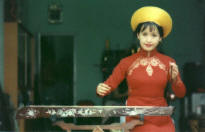 This
warning, probably coming from vigilant parents wishing to protect their
daughters from the emotional appeal of love songs played on this
instrument; this gives an idea of the power and charm of its music. This
warning, probably coming from vigilant parents wishing to protect their
daughters from the emotional appeal of love songs played on this
instrument; this gives an idea of the power and charm of its music.
According to the "Dai Nam thuc luc tien bien" the first dan
bau was made in 1770. At its first appearance it was a very simple
instrument comprised of a bamboo section, a flexible rod, a calabash or
half a coconut. After a process of evolution and improvement, the
present form of the dan bau is a bit more sophisticated, yet
still quite simple. It consists of an oblong box-shaped sound board,
slightly narrower toward one end, with a slightly warped top made of
unvarnished soft light wood, sides made of hard wood, and a bottom of
light wood pierced with holes for better sound. At one end of the sound
board is a flexible bamboo rod that goes through a dried calabash whose
bottom end has been cut out before being fixed on the sounding board. At
the other end of the sounding board is a peg made of wood or metal used
for tuning . The metal string, is attached to the rod and to the peg.
The pluck is a pointed stick of bamboo or rattan.
The notes played by the dan bau are smooth, sweet, and
captivating. In recent years success has been achieved in amplifying the
sound, causing an increase in volume and distance the that the sound
carries, while still preserving the quality of the sound.
The instrument is played solo or to accompany a poetry recital. During
recent years, it has taken a role in orchestral accompaniment to cheo
and cai luong opera. The dan bau has been performed
on major stages in foreign countries.
back
to top
 |
|
DAN TRANH (Tranh Zither)
The
tranh zither is also called the thap luc cam or
sixteen-stringed zither. The tranh zither appeared in Vietnam
in the time of the Tran dynasty (12th-13th centuries). It has a
rectangular sounding box, about 110 centimetres long that tapers about
13 cm toward an end , with a warped sound board made of unvarnished
light wood. The sides are made of hard wood decorated with various
designs, either lacquered or inlaid with mother-of-pearl. The bottom is
made of light wood with sound holes. The broader end of the sound box is
pierced with 16 holes and reinforced with a metal band.
Toward the middle of
the sound board there are 16 bridges made of wood or bone tipped with
copper that can be moved to vary the tension of the strings, thus
creating various notes. At the narrower end of the box are sixteen pegs
for tuning. The strings are metal and tuned to the pentatonic scale.
The range of the tranh zither is about three octaves, from
the notes C to C3. The player uses a plectrum and can play chords,
trills, tremolos... Her left hand, which manipulates the strings, can
use such techniques such as pressing, vibrato, glissando, etc.
The music of the
tranh zither is usually light and full of cheerfulness. The
instrument bears some likeness to the Japanese koto, the Korean Kayagum,
the Mongolian Jatac, the Chinese Zeng, and the Indonesian Kachap, which
have 13, 12, 12, 13-16, 7-24 strings, respectively. It is nonetheless an
original Vietnamese instrument with specific musical characteristics. It
is used to accompany poetry recitals and is quite often part of an
orchestra or a band playing chamber music, religious music, or
accompanying cheo or cai luong drama.
back to top
 |
|
DAN T'RUNG (Bamboo Xylophone)
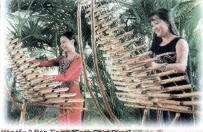 T'rung
is one of the popular musical instruments closely associated with
the spiritual life of the Bahnar, TSedan, Giarai, Ede and other ethnic
minority people in the Central Highlands of Vietnam. It is made of very
short bamboo tubes differing in size, with a notch at one end and a
beveled edge at the other. The long big tubes give off low-pitched tones
while the short small ones produce high-pitched tones. The tubes are
arranged lengthwise horizontally and attached together by two strings. T'rung
is one of the popular musical instruments closely associated with
the spiritual life of the Bahnar, TSedan, Giarai, Ede and other ethnic
minority people in the Central Highlands of Vietnam. It is made of very
short bamboo tubes differing in size, with a notch at one end and a
beveled edge at the other. The long big tubes give off low-pitched tones
while the short small ones produce high-pitched tones. The tubes are
arranged lengthwise horizontally and attached together by two strings.
There are three
types of T'rung: high, medium and low tones. The simplest
type is composed of five tubes corresponding to La, Do 1, Re 1, Fa 1,
Sol 1 and producing deep and resounding tones. In the majestic Central
Highlands, T'rung is often played after back-breaking farm work and
during evening get get-togethers in the communal house around a bonfire
with young boys and girls singing and dancing merrily. The sounds of the
gong and T'rung also mingle together at wedding parties
and village festivals.
The T'rung
instrument has been largely improved. More tubes have been added ,and at
times as many as 48 tubes are arranged in three arrays capable of
performing intricate piece of modern music while preserving the
traditional sound scale Some players have even invented a stick notched
at both ends for a single hand to produce two sounds at the same time,
heightening the artistry of the instrument.
Vietnam's national
music bands have never neglected the role of T'rung, an
instrument which is original and made of simple materials, but highly
appreciated at performances in the famous musical halls of many foreign
countries.
back to top
 |
|
DAN TAM
THAP LUC (36-string zither)
The 36-string zither
is a percussion instrument. It has the shape of an isosceles trapezoid,
with a slightly convex sound board made of light, porous, unvarnished
wood. The bridges and sides are made of hardwood. The bottom is flat.
There are two staggered lines of 18 bridges on the sound board. The
bridges on the left have hooks to which the strings are attached; those
on the right have pegs for tuning. The strings are of metal. Those on
the left, numbering 18, are tuned as follows:
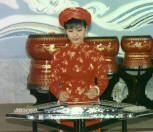
The range of the instrument
covers three octaves from C to B2. The strings are struck with two thin
flexible bamboo sticks tipped with felt.
The playing
technique includes a quick run, vibrato, stopping, and pressing. The
tones are bright and merry and the notes of an arpeggio can be played in
swift succession or simultaneously.
The instrument plays
an important role in the band accompanying cheo and cai luong
operas. The 36-string zither can be played to accompany instrument
solos, singing, or as part of an orchestra. Recently, more strings have
been added so that all semi-tones can be played.
back to top
 |
|
DAN NGUYET (Moon-Shaped
Lute)
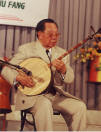 According
to ancient carvings, the moon-shaped lute appeared in Vietnam in the
11th century. Intended to be played by men, the lute has maintained a
very important position in the musical traditions of the Kinh.
Therefore, this instrument is widely used in their folk, court, and
academic music. According
to ancient carvings, the moon-shaped lute appeared in Vietnam in the
11th century. Intended to be played by men, the lute has maintained a
very important position in the musical traditions of the Kinh.
Therefore, this instrument is widely used in their folk, court, and
academic music.
The dan nguyet
is distinguished by its pure and loud sound, as well as by its great
capacity to express different emotions. Thus, it is heard at solemn and
animated ritual concerts, funerals, or refined chamber music recitals.
It can be played in solo, as part of an orchestra, or to accompany other
instruments.
Due to its long
neck and high frets, the dan nguyet is also used as an ornament
back
to top
 |
|
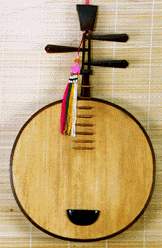 DAN
DOAN (Sun Lute) DAN
DOAN (Sun Lute)
Dan
Doan has a shape of the sun (bigger than the moon). Therefore, sometimes
people call it - Dan Nhat (Dàn Nhâ.t). It has 2 strings, a very short
neck, and the frets are right on the resonator box.
back to
top |

DAN K'LONGPUT
 This
musical instrument was intended for women. The name klong put of
Xe Dang origin has become the common name of this woodwind musical
instruments depicted to the right. It is played by ethnic groups in Tay
Nguyen, such as the Xe Dang, Bahnar, Gia Rai, Hre, etc. This
musical instrument was intended for women. The name klong put of
Xe Dang origin has become the common name of this woodwind musical
instruments depicted to the right. It is played by ethnic groups in Tay
Nguyen, such as the Xe Dang, Bahnar, Gia Rai, Hre, etc.
The k'long
put is
made of a set of 2 to 12 bamboo tubes. Each tube has a length ranging
from 60 to 200 cm and a diameter ranging from 5 to 8 cm. The tubes are
either opened at one end or at both ends. When played, the tubes are
laid horizontally and the player must either stand with her back bent or
kneel while clapping her hands to push air into the tubes to produce
sounds. Generally, each tube produces only one tone. However, some
ethnic groups use the hand to block one end of the tube to produce some
different pitches. With this technique, a two tube klong put can
produce four or five pitches.
A ccording
to a legend, this instrument is the residence of Mother Rice (goddess).
Therefore, it is closely associated with agricultural production, being
played exclusively by women on the field and at specific festivities,
such as eating new rice, closing the rice storage house, welcoming the
New Year, etc. The number of k'long put melodies is somewhat
limited. This instrument has been brought to stage by professional
artists who perform various pieces.
back
to top
. |
|
DAN NHI (Two-string
fiddle)
A
folksong of the north, a lullaby of the centre, or a cai luong
aria of the south will lose much of its charm if not accompanied by
the nhi, a traditional instrument capable of a great variety of
expression.
The nhi is a bow instrument with two strings, commonly used
among the Viet ethnic group and several national minorities: Muong, Tay,
Thai, Gie, Trieng, Khmer. The nhi comprises a tubular body made
of hard wood with snake or python skin stretched over one end and a
bridge. The neck of the nhi has no frets. Made of hard wood, one
end of the neck goes through the body; the other end slants slightly
backward. There are two pegs for tuning. The two strings, which used to
be made of silk, are now of metal and are tuned in fifths: C-1 D-2; F-1
C-2; or C-1 G-1.
The bow is made of bamboo or wood and fitted with horsehair,. The hair
goes through the space between the strings. The tones of the nhi
range over two octaves, from C-1 to C-3. In drawing the bow, the player
uses various techniques, including legato, vibrato, staccato; combined
with his fingering of the strings he can produce trills, glissando,
rapid runs, etc.
The
nhi is a highly expressive instrument which plays an important
solo and orchestral-role.
back to
top |
 |
|
 DAN
TAM (Three-string Lute) DAN
TAM (Three-string Lute)
As the name indicated, this lute composed of three silk strings. Dan Tam
can have very high sound. The tension of every string can vary freely to
produce melodious sounds. One intestestring thing is that Dan Tam is
fretless, The sound-box is usally decorated or covered with snake skin.
back
to top
 |
|
DAN TY BA (Pear-shaped
Lute)
Dan Ty Ba has a pear-shaped sound-box that becomes narrow toward its
upper end to form the neck. This instrument has 4 strings of braided
silk.
Dan Ty Ba was indispensable in the ancient eight-instrument musical
bands. The ty ba was mainly used in royal court orchestras, and was
rarely seen in popular musical bands.
back
to top
 |
|
SAO TRUC (Bamboo Flute)
 The
bamboo flute has long been attached to the cultural and spiritual life
of the Vietnamese. It can be said that the bamboo flute contains the
musical essence of the Vietnamese countryside together with the four
tranquil seasons. The
bamboo flute has long been attached to the cultural and spiritual life
of the Vietnamese. It can be said that the bamboo flute contains the
musical essence of the Vietnamese countryside together with the four
tranquil seasons.
The bamboo flute is made from the stem of fine bamboo with a diameter of
1.5cm and a length of about 30cm. On the stem there is one mouth piece
and 10 finger holes. It has piercing upper ranger which sound could cuts
through the large ensemble.
back
to top |
|
